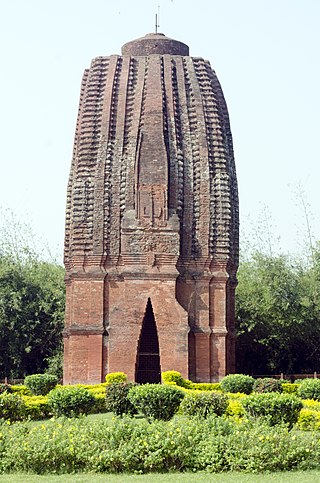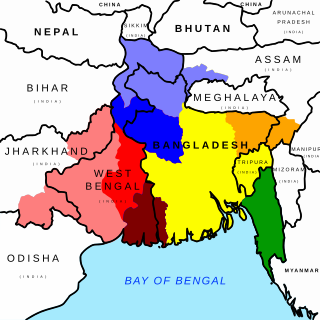
Barakar is a neighbourhood in Asansol, Paschim Bardhaman district in the Indian state of West Bengal. It is governed by the Asansol Municipal Corporation It is situated at the border of the states of Jharkhand and West Bengal. The Grand Trunk Road passes through Barakar. The neighbourhood is located on the banks of the river Barakar.

Chandrakona is a town and a municipality in the Ghatal subdivision of Paschim Medinipur district in the state of West Bengal, India. The city is located between Ghatal and Garhbeta. The king – Chandraketu was the founder of the kingdom of Chandrakona. In Ain-E-Akbari it was mentioned as ‘Mana’.

Kharar is a historical town of Ghatal and one of the oldest town in Asia. This city is located in the Ghatal Subdivision of the Indian state of West Bengal.
Ilambazar is a census town, with a police station, in Ilambazar CD block in Bolpur subdivision of Birbhum district in the Indian state of West Bengal. A traditional weaving and trading centre it serves as a gateway to Birbhum district.

Bahulara Ancient Temple is located in Bahulara village in the Onda II village panchayat, in the Onda CD block in the Bankura Sadar subdivision of the Bankura district in the Indian state of West Bengal. It is 5 km (3.1 mi) from Ondagram railway station and 25 km (16 mi) from Bishnupur.
Para is a village, with a police station, in the Para CD block in the Raghunathpur subdivision of the Purulia district in West Bengal, India.
Kogram is a village in Ketugram I CD block in Katwa subdivision of Purba Bardhaman district in West Bengal, India.

Narajole is a village and gram panchayat in Daspur I CD Block in Ghatal subdivision of Paschim Medinipur district in the state of West Bengal, India.
Nutanhat is a village in Mongalkote CD block in Katwa subdivision of Purba Bardhaman district in the state of West Bengal, India.

Paschim Bardhaman district is a predominantly urban mining-industrial district in West Bengal. The headquarter of the district is Asansol. It was formed on 7 April 2017 after bifurcation of the erstwhile Bardhaman district as the 23rd district of West Bengal.

Supur is a village under Raipur-Supur gram panchayat in Bolpur Sriniketan CD block in Bolpur subdivision of Birbhum district, West Bengal, India.

Jatar Deul is located in district South 24 Parganas of the Indian state West Bengal. This is a brick temple and is datable to c. 10th -11th century AD on the basis of its architecture. However, this type of brick temple we can see at Nebia Khera, Uttar Pradesh.

Ichhai Ghosher Deul is located near Gourangapur in the Indian state of West Bengal. It is a late mediaeval brick-built temple of the sikhara type without any image. Tradition says that Ichai Ghosh constructed the temple in honour of the Goddess Bhagabati. However, this type of brick temple seen at Neiba Khera, Uttar Pradesh.

Sat Deul is a 10th-11th century temple at Deule / Sat Deule in the Memari I CD block in the Bardhaman Sadar South subdivision of the Purba Bardhaman district in the Indian state of West Bengal.
Ambikanagar is a village and a gram panchayat in the Ranibandh CD block in the Khatra subdivision of the Bankura district in the state of West Bengal, India.
Bankati is a village in Kanksa CD block in the Durgapur subdivision of the Paschim Bardhaman district in the Indian state of West Bengal.
The Parvatinatha Temple is a saptadasa-ratna (seventeen-pinnacled) temple, built in the 19th century at Chandrakona in Ghatal subdivision of Paschim Medinipur district in West Bengal, India.
Gobindanagar is a village in the Daspur I CD block in the Ghatal subdivision of the Paschim Medinipur district in the state of West Bengal, India.

Bengal temple architecture is about temple styles developed and used in Bengal, particularly the chala, ratna and dalan temples.

Gopbhum or Gopbhumi is a historical region of West Bengal state in Eastern India. It included the entire area between the Ajay and Damodar rivers, which is present-day Purba Bardhaman, Birbhum, Jamtara, Purulia and Paschim Bardhaman districts of West Bengal. English translation of the word 'Gopbhum' is 'The land of Gopa'.


















